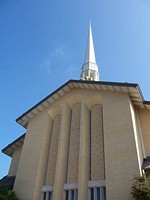Naked City
Eastern Exposure
By Emily Pyle, Fri., Oct. 27, 2000

The basketball court in the Givens Recreation Center was full of folding chairs, and the chairs were full of people, come to discuss what light rail's effect will be in East Austin. Foul acoustics and bad weather aside, most all of them stayed until the bitter end -- and it was bitter indeed.
Council Member Danny Thomas called the town hall meeting in order to answer questions and to "clear up misinformation" about light rail. According to Thomas's aide Linda Dailey, Thomas was also testing the waters before deciding whether or not to endorse the light rail proposal; on Tuesday, five days after the raucous Thursday night meeting, Thomas announced that he would not.
The "misinformation" that Thomas was calling on Capital Metro representative Karen Rae to clear up was abundant. So, for the record: Yes, the first phase of light rail will run through East Austin, in a two-mile loop that will run up the E. Fourth Street corridor and connect to Martin Luther King Blvd. No, Capital Metro will not seize private property to build any part of the line or any of its transfer stations. No, taxes will not be raised. And as far as anyone knows, no one from Capital Metro threatened to leave East Austin off the light rail line if they voted against it in November.
Will light rail stimulate economic growth? Or will it bring outside commercial interests into the area, stamping out local businesses and raising property values until longtime residents are forced to flee? On that matter, Capital Metro was a little less than certain. Why has the Eastside been left out of light rail negotiations until the very last minute? Well ...

From the spirit of the questions and the mood of the audience, light rail itself was clearly not the heart of the matter. When one of the moderators broke ranks to berate Rae and Capital Metro for a lack of African-Americans in supervisory positions (only about one in eight supervisory personnel are black, though nearly 40% of drivers are), it was obvious that the entity that was really on trial was Capital Metro itself -- and not only Cap Met, but Austin's city government in general, and its long history of ignoring those city officials deemed to be "on the wrong side of the tracks."
The mood of the evening was best summed up by former Planning Commissioner and current PODER member Susana Almanza, who compared light rail to the railroad that settled the west and displaced the continent's indigenous people. "Now the Iron Horse is coming back," Almanza said. The applause from the audience was thunderous.
The crowd may not have been as vehemently anti-rail as it looked and sounded, Dailey says. She suggests that they may have seized the opportunity to express outrage, not just at Capital Metro, but at years' worth of frustration and neglect.
The Eastside is "a little different from other areas," Dailey says. "There's a lot of resentment because of promises that were made and are still undelivered or were never kept. If you give people the opportunity to speak what they're feeling, you're going to hear something along those lines."
Thomas' response Tuesday was decidedly more measured, but no less adamant: "I am concerned with the adverse environmental, social, and economic impact" light rail could have on East Austin, Thomas said in a terse one-page release. Thomas lists the possibility of "adverse impact" on businesses along Congress Avenue and "disruption of neighborhood integrity" among his reasons for not supporting rail, but his stance must stem at least in part from the audience's outraged response to Capital Metro's presentation of Eastside light rail line.
But while it may be unclear whether light rail is the issue, one thing is clear: If voters in East Austin are angry enough, they could well be a stumbling block in light rail's path come November 7.
Got something to say on the subject? Send a letter to the editor.








